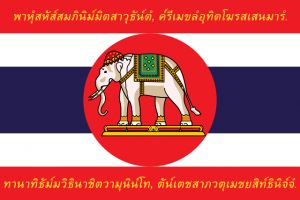Four Things That Make Thai Unique
By Sarah-Claire Jordan
 In the U.S., Thai tends to be used more in conversations regarding “What should we eat tonight?” rather than those discussing the actual language and the people who speak it. Lately, Thailand hasn’t been in the news much, and maybe that has contributed to our general lack of knowledge about it. Either way, we are missing out on a fair amount by not learning about Thailand, its people, and the language they speak.
In the U.S., Thai tends to be used more in conversations regarding “What should we eat tonight?” rather than those discussing the actual language and the people who speak it. Lately, Thailand hasn’t been in the news much, and maybe that has contributed to our general lack of knowledge about it. Either way, we are missing out on a fair amount by not learning about Thailand, its people, and the language they speak.
The Thai language is extremely interesting, being the national language of Thailand but also having speakers in China and other countries. Here are a few facts about Thai that will make you want to learn more about it:
1. There are different forms of Thai, depending on who you are talking to and in which setting
Thai, also known as Siamese, is the official language of Thailand, but there are different versions of the language that are used depending on who you are talking to and what you are talking about. Street, or common, Thai is used to talk with friends and family and is an informal form with no polite terms used. Elegant/formal Thai is the official and written version of Thai and is used in formal situations and in newspapers. Rhetorical Thai is reserved for public speaking, while religious Thai is only used when talking about Buddhism or talking to monks. Finally, royal Thai is used only when addressing the royal family or when talking about them.
2. There is not an official method for transcribing Thai into Latin script
This makes it harder for learners to get a grasp on the language, as the best way to learn it is to also learn Thai script. Lack of an official and standardized method of transcribing means that information about Thailand and Thai in languages using Latin scripts all use different transcription systems. For example, the name of the main airport in Thailand can be written as Suwunnapoom, Suvarnabhumi, or Suwannaphum.
3. More than half of Thai words are borrowed from other languages
This may not seem as much of a shocker for native English speakers, who are used to having a vocabulary of words borrowed from French, Spanish, German, and other languages, but most Thai vocabulary is borrowed too. Sanskrit and Pāli, both languages native to the Indian subcontinent, are the main source of vocabulary for Thai, but Old Khmer and the Teochew variety of Chinese have made their mark as well. For technical and scientific vocabulary, English has done its part in contributing vocabulary to the Thai language. Thai words that are not borrowed from other languages or compound words are generally only have one syllable.
4. Thai is an analytic language
This means that Thai verbs do not change due to subject, number, voice, tense, or mood. Instead, sometimes markers come before a verb to indicate tense, or other words in the sentence give away the tense, like “yesterday” or “already”. Negation and passive voice are indicated by markers, but otherwise, it is a matter of context.
For an overview of our translation expertise, visit our financial translation page
Category: Foreign Language








